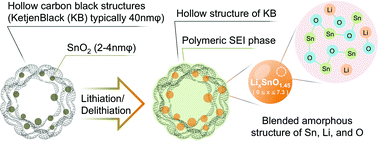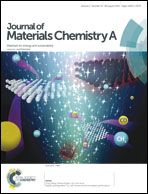The origin of anomalous large reversible capacity for SnO2 conversion reaction†
Abstract
Single-nanocrystalline SnO2 (2–4 nm ϕ) particles completely encapsulated within hollow-structured carbon black structures (Ketjen Black (KB), typically 40 nm ϕ) were prepared using our original in situ ultracentrifugation (UC treatment) materials processing technology. Ultracentrifugation at 75 000g induces an in situ sol–gel reaction that brings about optimized linking between limited-size SnO2 nanocrystals and microcrystalline graphitic carbons of KB. Efficient entanglement and nanonesting have been accomplished by simultaneous nanofabrication and nanohybridization in the UC treatment, specifically at a ratio of SnO2/KB = 45/55. This composite exhibited a reversible capacity of 837 mA h g−1 per composite, equivalent to 1444 mA h g−1 (per pure SnO2 after subtracting the capacity attributed to KB in the composite) for remarkably many cycles, over 1200. Such high performance in regard to both capacity and cyclability has never been attained so far for SnO2 anode materials. The reversibility of changes in the Sn valence state (defined as “formal valence state” in the manuscript) from Sn(2.9+) to Sn(4.4−) was demonstrated by in situ XAFS measurements during the lithiation–delithiation process. Peculiar nanodots of typically 2–4 nm that look like single-crystal SnO2/carbon core–shell structures were found for the optimized dose ratio (45/55) in the HRTEM observation. After 10 cycles, all the materials showed complete encapsulation of the same-sized nanoparticles, which were covered and nested within the KB matrix and an electrolyte-derived polymeric film. These results indicate that the initially prepared SnO2/KB composites were transformed into a new species, represented as LixSnO1.45 (x: 0–7.3), which shows perfect reversibility and cyclability. This species can exchange a total of 7.3 electrons, including 2.9 electrons for the conversion reaction (1–2 V) and 4.4 electrons for the subsequent alloying process (0–1 V).


 Please wait while we load your content...
Please wait while we load your content...